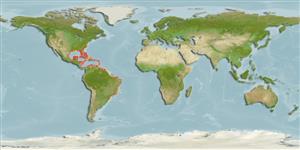Environment / Climate / Range
Ecology
Marine; reef-associated; depth range ? - 60 m (Ref. 89891). Tropical, preferred ?; 37°N - 33°S, 98°W - 34°W
Western Atlantic: North Carolina, USA to Rio de Janeiro, Brazil. Although reported from Bermuda by recent authors, this species is not native to the said country (Ref. 35505).
Size / Weight / Age
Maturity: Lm ? range ? - ? cm
Max length : 23.0 cm TL male/unsexed; (Ref. 7251); common length : 18.0 cm TL male/unsexed; (Ref. 5217)
Dorsal
spines
(total): 10;
Dorsal
soft rays
(total): 37-40;
Anal
spines: 2;
Anal
soft rays: 7. Black and white stripes on pale head and body; dark stripes more or less alternate in width, with wide bands slightly wider than diameter of pupil (Ref. 26938). First dorsal fin elevated; pelvic fins of adults usually just reaching anus (fins of juveniles greatly prolonged) (Ref. 13442).
Occurs in clear waters of tropical islands, especially near coral reefs, but also in adjacent bays over rough bottom. Also often found under eroded edges of seagrass beds (Ref. 26938). Has been reared in captivity (Ref. 35420).
Life cycle and mating behavior
Maturity | Reproduction | Spawning | Eggs | Fecundity | Larvae
Randall, J.E., 1996. Caribbean reef fishes. Third Edition - revised and enlarged. T.F.H. Publications, Inc. Ltd., Hong Kong. 3nd ed. 368 p. (Ref. 13442)
IUCN Red List Status (Ref. 115185)
CITES (Ref. 94142)
Not Evaluated
Threat to humans
Harmless
Human uses
Fisheries: minor commercial; aquarium: commercial
More information
ReferencesAquacultureAquaculture profileStrainsGeneticsAllele frequenciesHeritabilityDiseasesProcessingMass conversion
Tools
Special reports
Download XML
Internet sources
